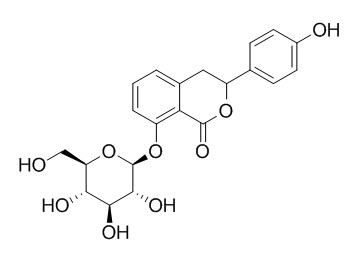Hydrangenol 8-O-glucoside
Hydrangenol 8-O-glucoside may have anti-inflammary activity.
Inquire / Order:
manager@chemfaces.com
Technical Inquiries:
service@chemfaces.com
Tel:
+86-27-84237783
Fax:
+86-27-84254680
Address:
1 Building, No. 83, CheCheng Rd., Wuhan Economic and Technological Development Zone, Wuhan, Hubei 430056, PRC
Providing storage is as stated on the product vial and the vial is kept tightly sealed, the product can be stored for up to
24 months(2-8C).
Wherever possible, you should prepare and use solutions on the same day. However, if you need to make up stock solutions in advance, we recommend that you store the solution as aliquots in tightly sealed vials at -20C. Generally, these will be useable for up to two weeks. Before use, and prior to opening the vial we recommend that you allow your product to equilibrate to room temperature for at least 1 hour.
Need more advice on solubility, usage and handling? Please email to: service@chemfaces.com
The packaging of the product may have turned upside down during transportation, resulting in the natural compounds adhering to the neck or cap of the vial. take the vial out of its packaging and gently shake to let the compounds fall to the bottom of the vial. for liquid products, centrifuge at 200-500 RPM to gather the liquid at the bottom of the vial. try to avoid loss or contamination during handling.
Exp Ther Med.2019, 18(6):4388-4396
Appl. Sci.2023, 13(17):9984.
J Chromatogr A.2017, 1518:46-58
J AOAC Int.2021, 104(6):1634-1651.
Agriculture2022, 12(12), 2173.
Saudi Pharm J2020, 10.1016
Plants.2024, 13(10):1348;
Food Funct.2021, 12(4):1469-1481.
Anticancer Res.2020, 40(10):5529-5538.
Molecules.2017, 22(11)
Related and Featured Products
Molecules. 2015 Dec 30;21(1):E43.
Turkish Scorzonera Species Extracts Attenuate Cytokine Secretion via Inhibition of NF-κB Activation, Showing Anti-Inflammatory Effect in Vitro.[Pubmed:
26729082]
Scorzonera species are used in different folk medicines to combat many diseases, including the illnesses connected with inflammation. Previous experiments showed anti-inflammatory activity of Scorzonera extracts in vivo. S. latifolia, S. cana var. jacquiniana, S. tomentosa, S. mollis ssp. szowitsii, S. eriophora, S. incisa, S. cinerea, and S. parviflora extracts were, therefore, evaluated for their inhibitory activities of TNF-α and IL-1β production, and NF-κB nuclear translocation in THP-1 macrophages.
METHODS AND RESULTS:
The HPLC analysis was carried out to elucidate and to compare the composition of these extracts. Major compounds of the tested extracts have been isolated using different chromatographic techniques and further tested for their inhibitory activities on TNF-α and IL-1β production. Several extracts showed promising anti-inflammatory activity in these in vitro tests. Results of HPLC analysis revealed chlorogenic acid as a compound present in all tested extracts. Hyperoside, quercetin-3-O-β-d-glucoside and rutin were also present in varying amount in some Scorzonera species analyzed. Furthermore, eight phenolics which were identified as quercetin-3-O-β-d-glucoside (1), hyperoside (2), Hydrangenol 8-O-glucoside (3), swertisin (4), 7-methylisoorientin (5), 4,5-O-dicaffeoyl-quinic acid (6), 3,5-di-O-caffeoyl-quinic acid (7), and chlorogenic acid (8) have been isolated as major phenolic compounds of the tested extracts and, together with eight terpenoids (9-16) previously obtained from different Scorzonera species, have been tested for the inhibition of TNF-α production, unfortunately with no activity comparable with standard.



